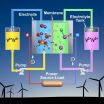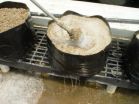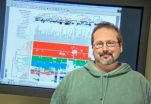The pilot study, currently published online in the Journal of Alzheimer's Disease, demonstrates how the immune gene MGAT3, which is essential in clearing amyloid beta, is expressed differently in different Alzheimer's patients. The finding may be useful in providing more highly individualized disease prognoses in the future.
It may also help researchers understand which patients will respond to therapy with vitamin D3 and curcumin, a chemical found in turmeric spice, both of which were shown in previous studies by this UCLA research team to help stimulate specific immune system cells to clear amyloid beta in a laboratory test.
Genes hold instructions to create proteins that determine all bodily processes, from moving blood through the veins to stimulating the immune system. The genome of each cell, which is made up of hereditary information, sends out messages to "turn on" various genes according to actual needs.
In earlier research, the UCLA team showed that Alzheimer's patients may have a defect in messaging from the MGAT3 gene, which could help explain why this population cannot effectively clear amyloid beta.
In the current study, researchers used a blood-based biomarker to identify three abnormal ways of processing MGAT3 gene information, which could lead to different disease prognoses.
"Alzheimer's disease robs a person of identity and is a huge burden for families, caregivers and society," said study author Dr. Milan Fiala, a researcher at the David Geffen School of Medicine at UCLA and the Veterans Affairs Greater Los Angeles Healthcare System. "This is one of the first studies demonstrating the role of the immune system in helping track Alzheimer's disease prognosis and the impact of therapies."
For the study, scientists drew blood samples from 20 Alzheimer's disease patients and 20 healthy controls and then isolated critical immune cells from the blood called macrophages, which are responsible for gobbling up amyloid beta and other waste products in the brain and body.
They incubated the immune cells overnight with amyloid beta to test the cells' ability to "turn on" MGAT3. They also added a synthetic form of curcumin to some of the cells to gauge the effect it had on MGAT3 expression and the absorption of amyloid beta.
Based on the results, the researchers identified three groups of Alzheimer's patients.
Type 0 patients: This group had very low expression of MGAT3 and very low absorption rates of amyloid beta.
Type I patients: This group also had low expression of MGAT3 and low amyloid beta absorption rates, but the strength of the MGAT3 message and the absorption of amyloid beta increased when researchers stimulated the macrophages with synthetic curcumin.
Type II patients: This group initially had high amyloid beta absorption rates, but when scientists added synthetic curcumin, MGAT3 expression lessened and absorption was reduced.
In addition, researchers found that for Type I and Type II patients, the clearing of amyloid beta was dependent on vitamin D3, a type of vitamin D that occurs naturally in these cells. When they blocked vitamin D3 use by the macrophages in the laboratory, they found that absorption of amyloid beta suffered.
"These findings demonstrate three very different levels of immunity and possible reactions to natural therapies of vitamin D3 and curcumin," Fiala said. "These differences could point to a new way to track the progression of Alzheimer's disease and the effectiveness of these natural therapies based on an individual patient's immunity."
Fourteen of the 20 Alzheimer's disease patients have been followed for two years, and researchers noted that those who were Type 0 had a worse two-year prognosis regarding the loss of their ability to live independently than the other two types of patients.
Fiala said that 45 percent of the Alzheimer's patients in the study were Type 0 in their MGAT3 immunity expression, while only 10 percent of the healthy controls fell into this patient type. The effects of vitamin D3 and curcumin have not yet been adequately investigated in Type 0 patients.
The healthy control group, made up of university professors, business people and Alzheimer's caregivers, displayed varying results in their ability to absorb amyloid beta. Overall, the university professors demonstrated good to excellent absorption of amyloid beta, and the caregivers displayed lower absorption rates. Fiala notes that the stress of caring for Alzheimer's patients may also affect the caregivers' immunity.
Fiala added that a larger clinical trial needs to be completed to validate findings from this pilot study. He said that while vitamin D3 seems to be helpful to most people, the benefits of synthetic curcumin are more individualized, depending on the patient. In the future, a commercially available test may be able to check for MGAT3 immunity.
During the study, researchers also noted that one Type II patient who underwent hip surgery experienced temporary cognitive dysfunction related to the general surgery anesthesia, which is a phenomenon that can occur. Researchers checked the patient's MGAT3 immunity and found that the patient's ability to clear amyloid beta had declined after surgery but improved in later months, along with cognitive function, possibly due to the vitamin D3 supplementation the patient had undertaken — although this was not a part of the study.
According to Fiala, this might be an example of how vitamin D3 may help improve amyloid beta clearance. He noted that this is early laboratory research and that no dosage of vitamin D or curcumin can be recommended at this time. Larger studies with more patients are planned.
INFORMATION:
The study was funded by the Alzheimer's Association.
Additional authors include Michelle Mahanian, Mark Rosenthal, Eric Tse, Tiffany Cho and Rachel Weitzman, Department of Medicine, Greater Los Angeles VA Medical Center and David Geffen School of Medicine at UCLA; Matthew T. Mizwicki, Department of Biochemistry, University of California, Riverside; James Sayre, Department of Biostatistics, University of California School of Public Health, Los Angeles and Verna Porter, Department of Neurology, David Geffen School of Medicine at UCLA.
For more news, visit the UCLA Newsroom and follow us on Twitter.
END




